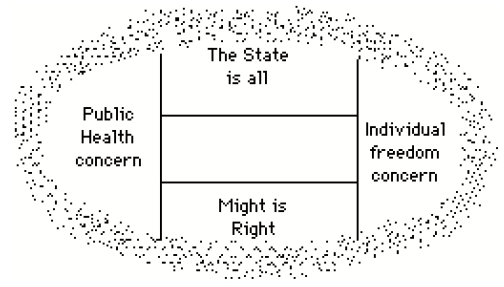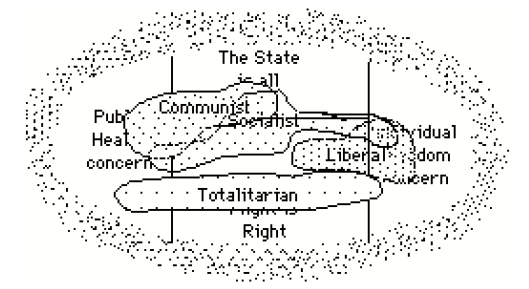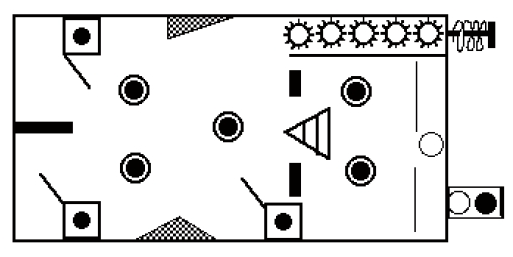Of course, even though these systons have names, the names do not always clearly define the systels involved. The War of the Roses was fought between the 'House of York' and the 'House of Lancaster' in England from around 1455 to 1499, and this was a civil war, in which the actual participants varied from day to day and had no clearcut territorial basis. At the time this was first being written, a civil war raged in Yugoslavia, in which a so-called 'Yugoslav Army' was attacking what was supposed to be part of Yugoslavia itself.
Nevertheless, even if the make-up of the systons involved is not entirely clear, it seems that the view that systons are involved in major conflicts, rather than individuals, is not particularly outrageous. Many other types of conflict could be looked at across the whole spectrum of human interactions, but perhaps we can generalize the situation with a Proposition:
Proposition 108A*. Most of the problems of human existence are due to conflicts
between syston and syston, or syston and individual, rather than between individuals
Searching for Peace -- What to Do?
One of the great desires of people generally is for peace. People do not want wars. So why do wars continue to occur?This matter may be looked at in more detail later. But for the moment, I will just put forward the last proposition again, for the special case of wars:
Proposition 108B*. Wars occur as a consequence of the dynamics of interaction of
country- and state-systons
Now that is not a very profound Proposition, but it is a start. The first step in improving a situation is to understand it. When we have understanding, we may see how to act to change the situation -- and perhaps also, whether the result of the achieved change will really lead to the aim desired.
Let us now look again at systons generally, using a new model to give a visual feel for how they interact.
The Matrix Cocoon
People often see things in fairly linear terms. In political systems, for example, a useful convention is to describe things as being, say, "leftish" or "to the right of Genghis Khan". Political diversity may be represented as positions on a range or spectrum, as in figure 108.1.
Now of course this is just a convenient representation, the communists are only 'to the left' by convention. Other scales have been used, it is interesting that the visible light spectrum has also been used, with the communists 'red' and the liberals 'blue'. But the point is that these ranges are all linear.
With Matrix Thinking we will try to get away from the linear approach, and represent things more generally. A representation we can use is that of the Matrix Cocoon (figure 108.2).

With this model, the whole Matrix of human affairs is thought of as like an egg-shaped cocoon (with fuzzy edges). In looking at any situation we can notionally allocate parts of the cocoon to different, often competing, aspects which interest us, as in figure 108.2.
Of course this representation is actually a cross-section across a three-dimensional cocoon. The allocation of aspects within the cocoon is purely arbitrary, to try and build up a picture which can be instinctively grasped.
We can then attempt to represent the underlying beliefs and assumptions of particular systons by mapping them on the matrix allocation, as in figure 108.3.

In theory, an aspect could be allocated a volume within the cocoon rather than an area in a cross-section, allowing representation of more complex interrelationships, but this makes the model harder to grasp. There is also a theoretical reason not to extend these models from two dimensions to three, which we will come to later.
This may be interesting, but what is its point here? What we are again approaching is the need, in MT, to clearly distinguish between different systons. After this, we can suggest rules by which the systons may interact.
In figure 108.3, the labels applied such as 'Communist' or 'Liberal' are just that, only labels. In any actual scenario, for an actual country, the labels may well be applicable to particular political party-systons, the 'Liberal Party', or whatever. The aim of mapping the systons on a matrix aspect cocoon is to clarify the relationships of the systons.
There is a danger in this sort of mapping. All systons change with time, and a mapping which was valid for a political party 20 years ago may have shifted dramatically since then. So a mapping cannot be regarded as fixed. And a mapping for a particular label in one country, say the 'Social Democrats', may have no similarity at all with the party of the same label in another country.
Going by the Rules
We now arrive at one of the most basic points in the use of Matrix Thinking to change human society, hopefully for the better. It is based on a Proposition which is not contentious, but rather is a working assumption which is seldom clearly stated as such. It concerns rules for the interaction of the segments and parts of society which we have here called systons.
Proposition 108C**. Voluntary rules can be set up for the operation of systons which
in themselves define the class to which the systons belong
Perhaps an example will help make the meaning of this Proposition clearer. Some states, like Western Australia, have rules for setting up a class of limited company called a Co-operative Company. These rules set up a company structure and method of operation rather different to that for an ordinary limited company. For example, each shareholder in a 'co-operative company' has one vote, irrespective of how many shares they hold, and company profits are distributed by rebates on shareholder financial activity, rather than as dividends.
The point here is this. A group of people wishing to start up a company to run under the rules of the 'Companies (Co-operative) Act' will normally have the desire to operate under rather different principles to those of a normal limited company. Their action in incorporating their new company under a particular act is voluntary -- they could choose from a range of Acts allowing the incorporation of many different types of body.
The role of the Western Australian Government has been to set up a number of allowable company structures, each of which has an associated set of rules. The rules are voluntary in the sense that if you don't like them, you can choose a different set, and incorporate your company under those. Once you have chosen your company structure, the set of rules for that structure are compulsory.
By choosing a particular Act under which to incorporate your company, you automatically define the company-syston class to which your company belongs. It may be a Public Limited Company, a Co-operative Company, a No-Liability Company, or whatever; it cannot be more than one at the same time.
Setting up Rule Structures
Now there is nothing exceptional in all this. The company example has been chosen here because it is quite well-defined and familiar. The importance of the matter from the MT viewpoint is the proposition that this situation is applicable to all systons.As we progress it will be appropriate to suggest particular sets of rules, particular Rule Structures, for particular syston scenarios. The point that these rules are voluntary, in the sense that a choice can be made on which set of rules is to be followed, has already been made. A further point is that any given set of rules is not immutable, but can be expected to undergo evolution and amendment as circumstances change.
Even so, it is convenient to have labels for particular Rule Structures, as is done in the case of setting up different types of company. To change these particular 'company' Rule Structures, amendment to an Act of legislation is usually required, and the change is relatively clearly flagged to the community. Other Rule Structures may be much less formally defined, and changes in these can take place continuously and imperceptibly.
Setting up a Rule Structure involves a considerable amount of infocap input, so the setting-up process can be viewed as one which increases infocap. In the final Proposition of this article, this point will be formalized as a particular example of the perceived benefits of infocap accumulation.
Proposition 108D***. A syston is advantaged by the availability of a large set of
competing voluntary Rule Structures which can operate within it

